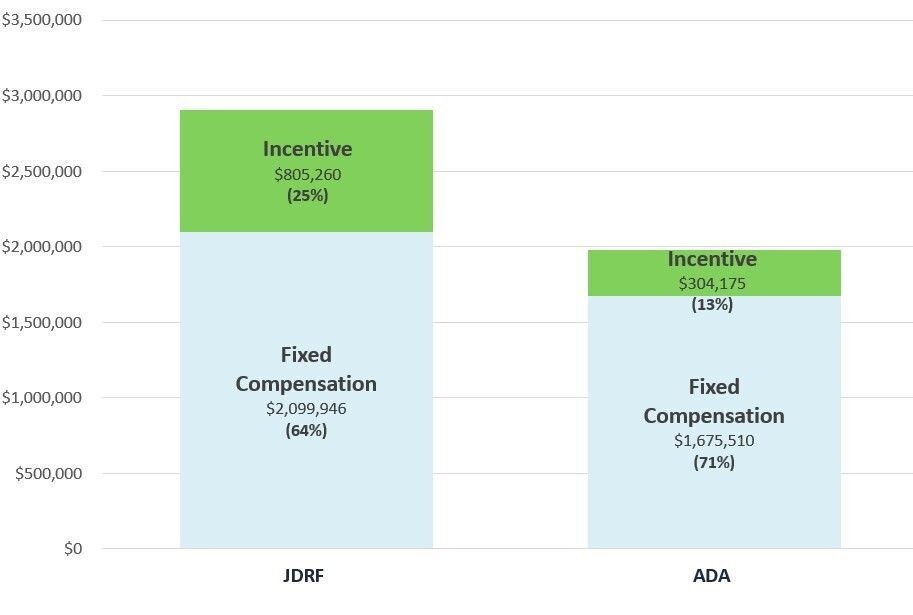
October 5, 2023
This is the JDCA’s 12th annual review of top executive compensation at two of the most significant nonprofits funding T1D research: the Juvenile Diabetes Research Foundation (JDRF) and the American Diabetes Association (ADA). All information in this report is based on up-to-date financials regarding fiscal year 2022 (FY22), currently in the public record. The importance of this analysis is that it sheds light on organizational priorities and objectives, following the adage, ‘You get what you pay for.’
Top executives at diabetes nonprofits are some of the highest-paid in their field. The two highest-paid individuals were, unsurprisingly, the Chief Executive Officers (CEO). JDRF CEO Aaron Kowalski earned $823K in FY22, while ADA CEO Charles Henderson, who took up the mantle mid-year, earned $805K in FY22 (see Appendix A). Henderson’s compensation is much less than his predecessor, Tracey Brown, who left the organization in October 2021. Brown’s compensation in FY21 was a staggering $1.2M.
Kowalski and Henderson are in the top 1% of earners in the US, but their compensation is well within the range of other nonprofit organization CEOs (see chart B). However, at the ADA, CEO pay, as a percent of total organization revenue, is at the top of the chart for both Henderson and Brown. Their compensation in FY22 and FY21 is noticeably outsized and surprisingly generous given the revenue level, in comparison to the other 10 organizations in our analysis (see chart B), and we are surprised the ADA board continues to approve these compensation levels given that the ADA is no longer as large as it once was. (ADA revenue has steadily dropped by -50% from ten years ago, from $228M in FY12 to $119 in FY22.)
The JDCA supports competitive compensation for senior executives. Big paychecks for exceptional leaders are appropriate if performance is delivered. Competitive executive pay provides nonprofit organizations the ability to attract and retain highly qualified and dedicated leaders who can deliver clear progress toward a T1D cure. However, high compensation should be justified; a reward for a job well done, seen in tangible progress toward a T1D cure and positive impact on the organization overall.
Under the current pay structure, only a small portion of executive compensation is based on performance incentives. The majority is a fixed, base pay guaranteed regardless of the CEO’s efficacy in the position.
In addition, as of today, donors cannot influence how much executives are paid at these institutions. The JDCA believes that by evolving the pay model to provide donors with a ‘Say on Pay,’ T1D nonprofits can accelerate a T1D cure.
Summary Points:
- 71% of ADA executive compensation was guaranteed base pay in FY22. Only 13% was performance-based (see Appendix C).
- 64% of JDRF executive compensation was guaranteed base bay in FY22. A solid 25% was performance-based.
- $805K—The amount paid in FY22 to ADA CEO Charles Henderson during the lowest revenue year in the past 17 for the ADA (see Appendix C).
- $1.2M—The amount paid to Tracey Brown in FY21.
- JDRF T1D Fund executives take 2 of the 5 top spots for the first time, suggesting that a big part of their pay is based on profitable investment exits.
- The biggest annual bonus of the 10 top executives was to Steven St. Peter, a managing director of the JDRF T1D Fund. 42% of his $751K annual compensation was incentive-based, making him the second highest-paid executive at JDRF after the CEO.
- This is the first time in the 10 years tracking the top five executives at the JDRF that no scientists or research grant leaders were in the top 5 most compensated executives, suggesting a possible shift in priority.
Performance-Based Pay Delivers Results
At the highest-performing for-profit companies, top executives’ annual compensation is often directly correlated to performance. The better the company does, the more executives are rewarded. This form of incentive creates a powerful professional and personal zeal to drive the company toward palpable results that benefit stakeholders and shareholders alike.
Unfortunately, this business model does not usually carry over to nonprofit organizations. The JDCA believes this is a missed opportunity to drive passion, accentuate focus, and improve overall performance toward achieving organizational goals.
‘Say on Pay’ Can Help Deliver a Practical Cure
Attributes dictating employee compensation from the JDRF and ADA are not made transparent to donors. A compensation strategy is created by a committee within the Board of Directors, which later provides annual approval for performance-based pay. The average donor is omitted from these decision-making processes.
The JDCA recommends adopting a ‘Say on Pay’ model to nurture the relationship between donor interest and executive compensation. Corporations with ‘Say on Pay’ provisions allow shareholders to vote on specific aspects of executive compensation, like pay structure, base pay, and bonuses. ‘Say on Pay’ would make T1D nonprofit executives accountable to T1D donors in the same way for-profit executives are accountable to shareholders.
Note: All tax-exempt nonprofit organizations must file an annual IRS Form 990 to report their mission, finances, and achievements. 990 forms are created specifically to facilitate financial transparency to the public, and here act as the foundation for this report. All information in this report is based on up-to-date financials currently in the public record found on each organization’s website. Information regarding JDRF is based on their FY22 (July 1, 2021-June 30, 2022) IRS Form 990. Information regarding the ADA is based on their FY22 (calendar year January 1, 2022-December 30, 2022) IRS Form 990.
Appendix A: Compensation of the Top 5 ADA and JDRF Executives

Appendix B: Nonprofit CEO Compensation Comparison

Source: IRS Form 990s
Appendix C: Guaranteed Versus Performance-Based Income (FY22)
Regarding Top Five Highest Paid Executives

Links to IRS Form 990s used in this report:
ADA (FY21): Click here.
ADA (FY22): Click here.
Alzheimer's Association: Click here.
American Cancer Society: Click here.
American Heart Association: Click here.
American Kidney Fund: Click here.
Helen Keller International: Click here.
JDRF: Click here.
Leukemia & Lymphoma Society: Click here.
Michael J. Fox Foundation: Click here.
National Multiple Sclerosis Society: Click here.
Susan G. Komen: Click here.
